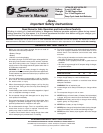
2
PERSONAL PRECAUTIONS AND SAFETY
PREPARING TO CHARGE
1. Check the battery voltage. This charger is for 12 volt batter-
ies only.
2. Clean battery terminals. Take care to keep corrosion from
coming in contact with your eyes.
3. If required, add distilled water in each cell until battery acid
reaches levels specified by battery manufacturer. This helps
purge excessive gas from cells. Do not overfill. For a bat-
tery without cell caps, carefully follow manufacturer's re-
charging instructions.
4. Study all battery manufacturer's specific precautions, such
as removing or not removing cell caps while charging, and
recommended rates of charge.
5. Be sure area around battery is well ventilated while battery
is being charged. Gas can be forcefully blown away by us-
ing a piece of cardboard or other non-metallic material as a
fan.
6. If necessary to remove battery from vehicle to charge, al-
ways remove grounded terminal from battery first. Make
sure all accessories in the vehicle are off, so as not to cause
an arc.
7. A marine (boat) battery must be removed and charged on
shore. To charge it on board requires equipment specially
designed for marine use.
BATTERY SIZE/RATING
CAR / LIGHT CCA RES. RECHARGE
TRUCKS CAP TIME-HOURS
200-315 40-60 3-5
315-550 60-85 5-9
550-850 85-150 9-13
MARINE / OR MCA AMP HR
DEEP CYCLE 220-350 24-40 3-5
350-600 40-70 5-9
600-935 70-104 9-13
CCA: COLD CRANKING AMPS RES. CAP.: RESERVE CAPACITY
MCA: MARINE CRANKING AMPS AMP HR: AMPERE HOUR
or another electrical devise. Sparking may cause an
explosion.
7. Always operate battery charger in an open well ventilated
area.
8. Battery chargers get hot during operation and must have
proper ventilation. Air needs to flow around entire charger.
9. Do not set battery charger on flammable items like carpeting,
upholstery, paper, cardboard etc. Charger may damage
leather and melt plastic and rubber.
10. NEVER smoke or allow a spark or flame in the vicinity of
the battery or engine. Batteries generate explosive gases!
1. WARNING: Wear complete eye protection and clothing
protection, when working with lead-acid batteries.
2. Make sure someone is within range of your voice or close
enough to come to your aid when you work with or near a
lead-acid battery.
3. Have plenty of fresh water and soap nearby for use if battery
acid contacts skin, clothing, or eyes. If battery acid contacts
skin or clothing, wash immediately with soap and water.
4. Avoid touching your eyes while working with a battery. Acid
particles (corrosion) may get into your eyes! If acid enters
your eye, immediately flood eye with running cold water for
at least 10 minutes. Get medical attention immediately.
5. Remove all personal metal items such as rings, bracelets,
necklaces, and watches when working with a lead-acid
battery. A lead-acid battery can produce a short-circuit
current high enough to weld a ring (or the like) to metal,
causing a severe burn.
6. Take care not to drop a metal tool or other metal onto the
battery. Metal may cause sparking or short circuit the battery
CHARGE TIME USING THE 2 AMP RATE
WITH SMALL AND MEDIUM SIZE BATTERIES
SIZE IN RECHARGE TIME
AMP HR IN HOURS
LAWN & GARDEN 20-30 12-18
EQUIPMENT 30-40 18-24
MOTORCYCLE 10-15 6-9
15-24 9-21










